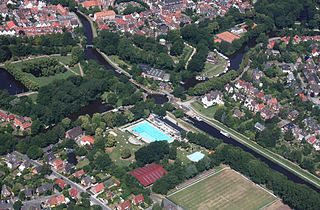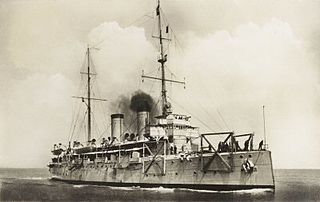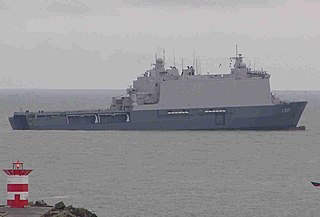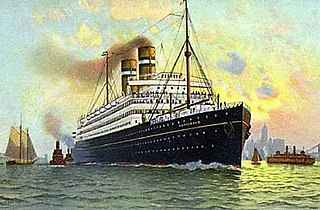
The German Navy is part of the unified Bundeswehr, the German Armed Forces. The German Navy was originally known as the Bundesmarine from 1956 to 1995, when Deutsche Marine became the official name with respect to the 1990 incorporation of the East German Volksmarine. It is deeply integrated into the NATO alliance. Its primary mission is protection of Germany's territorial waters and maritime infrastructure as well as sea lines of communication. Apart from this, the German Navy participates in peacekeeping operations, and renders humanitarian assistance and disaster relief. It also participates in anti-piracy operations.

Rotterdam is the second-largest city in the Netherlands after the national capital of Amsterdam. It is in the province of South Holland, part of the North Sea mouth of the Rhine–Meuse–Scheldt delta, via the "New Meuse" inland shipping channel, dug to connect to the Meuse at first and now to the Rhine.

Emden is an independent city and seaport in Lower Saxony in the northwest of Germany, on the river Ems. It is the main city of the region of East Frisia and, in 2011, had a total population of 51,528.
Holland America Line N.V. (HAL) is an American-owned cruise line, a subsidiary of Carnival Corporation & plc headquartered in Seattle, Washington, United States.

Borealis is a cruise ship of Fred. Olsen Cruise Lines, sailing since July 2021. She was built as MS Rotterdam and was the co-flagship for Holland America Line, for which she sailed for 22 years.

The fifth SS Rotterdam, also known as "The Grande Dame", is a former ocean liner and cruise ship, and has been a hotel ship in Rotterdam, Netherlands, since 2010. She was launched by Queen Juliana of the Netherlands in a gala ceremony on 13 September 1958, and was completed the following summer.

HNLMS Gelderland was a Holland-class protected cruiser of the Royal Netherlands Navy. During its career in the Dutch Navy it was most notable for being the ship Queen Wilhelmina sent to Portuguese East Africa to transport Paul Kruger to Europe during the Second Boer War. The ship was taken over by the Germans during World War II, rebuilt as an anti-aircraft cruiser and renamed Niobe. Commissioned into the German navy on 1 March 1944, she was sunk in Kotka harbour in Finland on 16 July 1944.

The Rotterdamsche Droogdok Maatschappij NV (RDM) was a major shipbuilding and repair company in Rotterdam in the Netherlands, existing from 1902 to 1996. It built 355 ships, 18 of which were submarines. During its existence, the shipyard operated 12 floating docks and employed 7,000 people at its peak.

HNLMS Rotterdam is the lead ship in the Rotterdam-class landing platform dock of the Royal Netherlands Navy. The ship is named after the Dutch city of Rotterdam.

SMS Rostock was a light cruiser of the Karlsruhe class built by the German Kaiserliche Marine. She had one sister ship, SMS Karlsruhe; the ships were very similar to the previous Magdeburg-class cruisers. The ship was laid down in 1911, launched in November 1912, and completed by February 1914. Armed with twelve 10.5 cm SK L/45 guns, Rostock had a top speed of 28.5 knots and displaced 6,191 t at full load.

The Karlsruhe class of light cruisers was a pair of two ships built for the German Imperial Navy before the start of World War I. The ships—SMS Karlsruhe and Rostock—were very similar to the previous Magdeburg-class cruisers, mounting the same armament and similar armor protection, though they were larger and faster than the earlier ships. Both vessels were laid down in 1911, and launched one day apart, on 11 and 12 November 1912. Karlsruhe joined the fleet in January 1914, but fitting out work lasted slightly longer on her sister; Rostock was commissioned the following month.
Walter L M Russ was a 1,538 GRT cargo ship built in 1927 in Rostock, Germany. In 1945, she was seized by the Allies and passed to the Ministry of War Transport (MoWT). It was intended that she would be renamed Empire Concourse but in July 1945 she ran aground between Wales and Ireland, and was wrecked.
Theresia L M Russ was a 1,694 GRT cargo ship that was built in 1927 by Neptun AG, Rostock, Germany for Ernst Russ. She was requisitioned by the Kriegsmarine for two years during the Second World War. In 1944, she was sunk by bombing at Gotenhafen, German occupied Poland. The ship was raised and repaired in 1945. She was seized by the Allies at Copenhagen and passed to the Ministry of War Transport (MoWT) and renamed Empire Concrete.
Charlotte Cords was a cargo ship that was built in 1923 by Neptun AG, Rostock for German owners. She was seized by the Allies in Travemünde in May 1945, passed to the Ministry of War Transport (MoWT) and renamed Empire Connah. In 1946, she was allocated to the Soviet Government and renamed Nikolai Bauman. The ship was scuttled while carrying a cargo of nuclear waste in 1964.

HNLMS Johan de Witt is the second Rotterdam-class landing platform dock of the Royal Netherlands Navy. It is an improved design of Rotterdam, which was designed in conjunction between the Netherlands and Spain. The ship, displacing 16,800 tons, was launched on 13 May 2006. The motto of the ship is Ago Quod Ago, translated as I do what I do.

HNLMS O 12 was a O 12-class submarine of the Royal Netherlands Navy. Built at Koninklijke Maatschappij De Schelde in Vlissingen, she was launched in 1930 but was unable to take part in military action during World War II. After being scuttled by the Dutch Navy, she was raised by Nazi Germany's Kriegsmarine and taken into service as UD-2, and then scuttled again.
O 11 was a O 9-class patrol submarines of the Royal Netherlands Navy. The ship was built by Fijenoord shipyard in Rotterdam.
SS Rotterdam was a Dutch passenger ship that ran aground and sunk on the Zeehondenbank near the Dutch island of Schouwen, while she was travelling from New York, United States to Rotterdam, The Netherlands.

The Groningen class was a class of steam corvettes of the Royal Netherlands Navy. The class comprised Groningen, Citadel van Antwerpen and Vice-Admiraal Koopman

SS Rotterdam was a steam ocean liner that was launched and completed in Ireland in 1908, and scrapped in the Netherlands in 1940. Holland America Line (HAL) owned and operated her throughout her career. She was the fourth of seven HAL ships to have been named after the Dutch city of Rotterdam. Until Statendam entered service in 1929, Rotterdam was the largest and swiftest ship in the company's fleet, and was the company's flagship.













